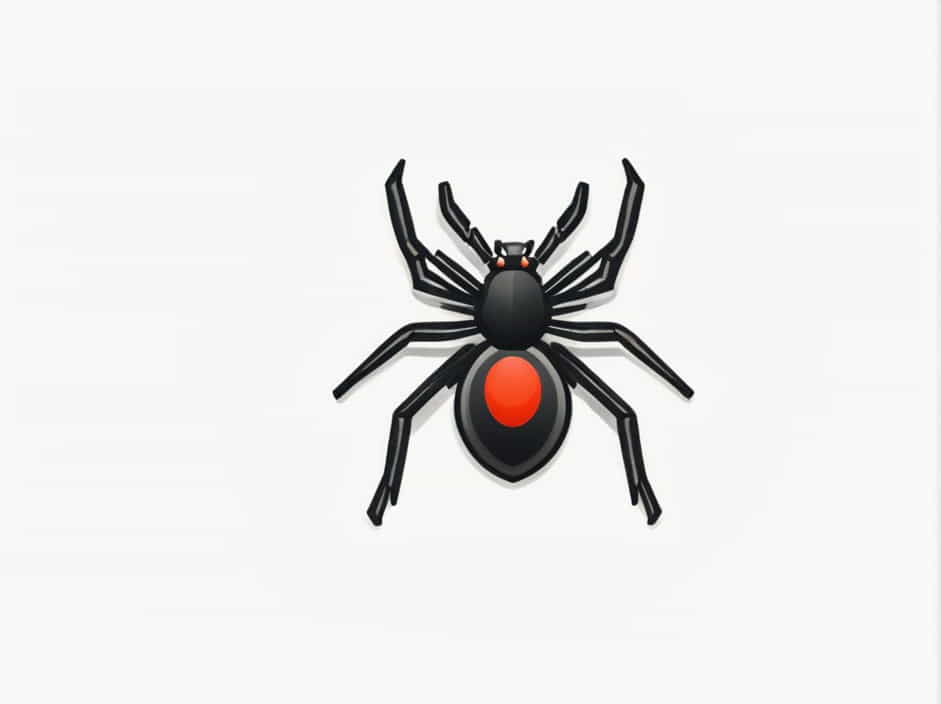The black widow spider is one of the most well-known and feared spiders in the world. Famous for its shiny black body and red hourglass marking, this spider has a reputation for being highly venomous. But how dangerous is it really? What does it eat, and where can you find it?
In this topic, we will explore the appearance, habitat, behavior, and venom of the black widow spider.
1. What Does a Black Widow Spider Look Like?
The black widow spider is easily recognizable due to its sleek, black body and distinctive red markings.
Physical Characteristics
- Body Size: Adult females are about 1.5 inches (3-4 cm) long, while males are much smaller.
- Color: Females are glossy black with a red or orange hourglass marking on their abdomen. Males are lighter in color, often brown or grayish.
- Legs: They have long, thin legs that help them move quickly.
- Web: Black widow spiders weave irregular, messy webs, often found in dark corners.
The female black widow is the one people usually notice, as males are smaller, less colorful, and rarely seen.
2. Where Do Black Widow Spiders Live?
Black widow spiders are found all over the world, but they are most common in North America, particularly in the southern and western United States.
Preferred Habitat
- Dark, sheltered areas such as basements, sheds, garages, and crawl spaces.
- Outdoor locations like woodpiles, rock crevices, and under logs.
- Warm climates, as they prefer temperatures above 70°F (21°C).
These spiders like to stay hidden during the day and come out at night to hunt.
3. What Do Black Widow Spiders Eat?
Black widow spiders are carnivorous and feed mainly on insects and other small arthropods.
Common Prey
- Flies
- Mosquitoes
- Grasshoppers
- Beetles
- Other spiders
How They Hunt
Black widows use their strong, sticky webs to trap prey. Once an insect gets caught, the spider quickly injects it with venom to paralyze and digest it. Unlike some spiders, black widows do not chase their prey; they rely on their web to do the work.
4. Are Black Widow Spiders Dangerous?
Black widow spiders are often feared because of their venom, but how dangerous are they to humans?
Venom and Its Effects
- Black widow venom contains a neurotoxin called latrotoxin, which affects the nervous system.
- A bite can cause muscle pain, cramps, sweating, and nausea.
- Severe reactions are rare but can occur in young children, elderly individuals, or those with weak immune systems.
How Often Do They Bite?
Black widows are not aggressive and usually bite only when they feel threatened. Most bites happen when someone accidentally touches or disturbs their web.
What to Do If Bitten
- Stay calm – most bites are not life-threatening.
- Wash the bite area with soap and water.
- Apply ice to reduce swelling.
- Seek medical help if you experience severe pain, difficulty breathing, or muscle cramps.
Although black widow bites are painful, they are rarely fatal, especially with modern medical treatment.
5. Do Black Widow Spiders Eat Their Mates?
One of the most famous myths about black widows is that females eat males after mating. But is this true?
The Truth About Mating Behavior
- In some cases, the female does eat the male after mating, but this is not always the case.
- Males often escape after mating if they move quickly.
- This behavior is more common in captivity than in the wild.
While it does happen, the idea that all female black widows kill their mates is an exaggeration.
6. How to Prevent Black Widow Spiders in Your Home
If you want to avoid black widow spiders in your home, follow these tips:
a) Keep Your Home and Yard Clean
- Remove clutter from garages, sheds, and basements.
- Seal cracks in walls and windows to prevent entry.
- Keep woodpiles and rocks away from your house.
b) Reduce Their Food Source
- Keep your home free of insects, as they attract spiders.
- Use bug screens on windows and doors.
c) Be Careful in Dark, Hidden Areas
- Wear gloves when handling firewood or cleaning out storage areas.
- Check for webs before reaching into dark corners.
By keeping your home clean and free of insects, you can reduce the chances of finding a black widow spider inside.
7. Interesting Facts About Black Widow Spiders
- Only the females are dangerous – male black widows and juveniles do not pose a threat.
- Their webs are extra strong compared to other spider species.
- They get their name from the belief that females kill their mates, but this is not always true.
- Despite their reputation, black widow spiders prefer to avoid humans.
- Birds, wasps, and other spiders prey on black widows, keeping their population in check.
The black widow spider is a small but fascinating creature with a strong reputation. While its venom is powerful, it rarely causes serious harm to humans. Black widows prefer to stay hidden and only bite in self-defense.
Understanding their habitat, behavior, and appearance can help you identify and avoid them. By keeping your home clean and clutter-free, you can reduce the risk of encountering these spiders.
Despite their scary reputation, black widow spiders play an important role in controlling insect populations and maintaining balance in nature.
